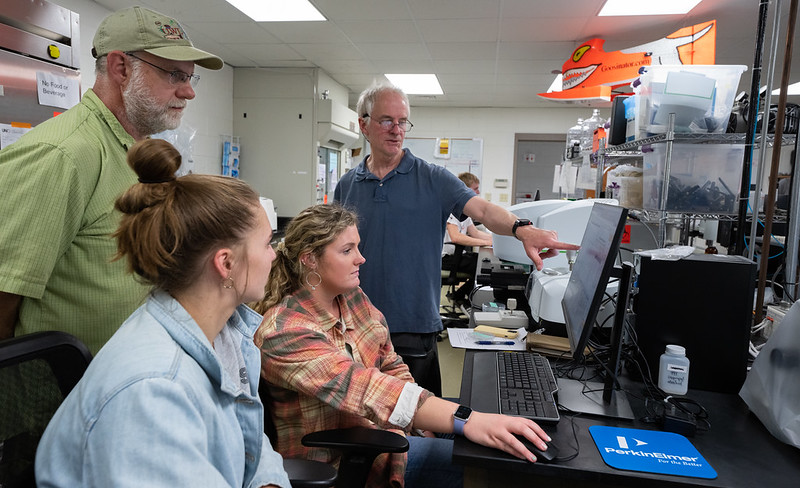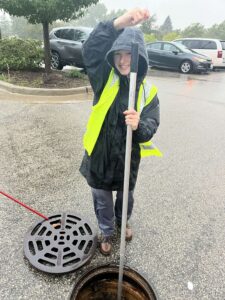Microplastics in aquatic environments pose a major threat to humans and animals, but until fairly recently, they were overlooked in terms of research and plastic pollution monitoring programs.
In 2018 when Courtney Baker, then an undergraduate student at UW-La Crosse, approached Professor Eric Strauss about researching microplastics, they thought it would be easy.
“We thought we’d get a net and find plastics in the water. It was much more complicated,” he says.
At the time, there were few research protocols for this emerging contaminant, and most sampling was being done in the ocean. To their knowledge, no one was studying samples taken from the Mississippi River, which had different vegetation and a lot more mud. Baker recalls using a basic net with a filter cup with mesh sides to do timed drags through the water. She had to identify and count the tiny plastics by hand.
Fast forward five years, and the techniques have advanced significantly. Strauss connected with Professor Bob Stelzer at UW Oshkosh and in 2020, Strauss, Stelzer, and Professor Greg Kleinheinz at UW Oshkosh received a grant from the Freshwater Collaborative of Wisconsin to involve more undergraduate students in their research. (Baker had moved onto graduate school by that point.)

“The idea was that I am on the west side of state by the Mississippi, and he’s on the east side by Lake Winnebago. They are very different systems,” Strauss says. “We wanted to compare the organisms they had in common and the level of plastics in those organisms.”
Their goal was to identify critical baseline information about the extent of microplastic contamination in the two bodies of water, which are significant sources of drinking water. The grant also allowed them to strengthen partnerships with the Wisconsin Department of Natural Resources, which was engaged in monitoring the water quality of the Upper Mississippi River but wasn’t monitoring microplastics.
The research got a big boost when UW Oshkosh received additional Freshwater Collaborative funding to purchase a Fourier Transformed Infrared (FTIR) spectrometer for its Environmental Research and Innovation Center lab.
Now undergraduate students are using FTIR technology to detect and identify microplastic particles in Wisconsin lakes and rivers. Some are looking at the presence of microplastics in fish, which may experience adverse health effects and impacts on reproduction and growth. Others are looking at microplastics in mussels, which may disrupt food webs and influence environmental health.
“This instrument is expensive. Students don’t get exposure to this type of instrument in the classroom,” says Strauss, who has taken UW-La Crosse students to UW Oshkosh to train on the spectrometer. “A lot of students have benefit from this project. It’s why these research experiences are so valuable.”
Jackie Behrens, who will graduate from UW Oshkosh in December, began volunteering on the project in 2021. Thanks to Freshwater Collaborative funding, she became a paid assistant researcher. Behrens notes that she and her team had to develop many of the methods they use to study microplastics in mussels because little research had been done previously. She also conducted her own research project on microplastics in stormwater.

“I’ve learned to always be adaptive and the importance of quality control,” she says. “My favorite part of this research was gaining a greater awareness about microplastics in our environment. I really started to pay attention to how much plastic was in my life and to find ways I can prevent microplastic pollution.”
Stelzer says the students taking part in the project are getting invaluable experience that will further their development as scientists and student researchers. Their experience also will bolster their prospects for getting hired in their fields of study.
One of the UW-La Crosse students who participated in the project was hired by the WDNR. Behrens was recently hired as a full-time research scientist at the UW Oshkosh ERIC lab. Her position is paid for through grant funds, and she will start the week after graduation.
Determining the sources of the microplastics and macro plastic debris will also help inform future outreach, mitigation and education activities in Wisconsin.
“We hope that with the Freshwater Collaborative money and this project, we can distribute information with numbers to back it up,” Strauss says. “These are systems that are local, and that’s important because the citizens of Wisconsin are going to care about what we’re finding in local bodies of waters.”
This story was co-written by Shane Nyman, UW Oshkosh, and Heidi Jeter, Freshwater Collaborative of Wisconsin.

